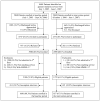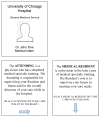Improving inpatients' identification of their doctors: use of FACE cards
- PMID: 20043501
- PMCID: PMC3188440
- DOI: 10.1016/s1553-7250(09)35086-2
Improving inpatients' identification of their doctors: use of FACE cards
Abstract
Background: Improving patients' ability to identify their inpatient physicians and understand their roles is vital to safe patient care. Picture cards were designed to facilitate physician introductions. The effect of Feedback Care and Evaluation (FACE) cards on patients' ability to correctly identify their inpatient physicians and on patients understanding of physicians roles was assessed.
Methods: In October 2006, team members introduced themselves with FACE cards, which included a photo and an explanation of their roles. During an inpatient interview, research assistants asked patients to name their inpatient physicians and trainees and to rate their understanding of their physicians' roles.
Results: Of 2,100 eligible patients, 1,686 (80%) patients participated in the baseline period, and 857 (67%) of the 1,278 patients in the intervention period participated in the evaluation. With the FACE intervention, patients were significantly more likely to correctly identify at least one inpatient physician (attending, resident, or intern; baseline 12.5% versus intervention 21.1%; p < .001). Of the 181 patients who were able to correctly identify at least one inpatient physician in the intervention period, research assistants noted that 59% (107) had FACE cards visible in their rooms. Surprisingly, fewer patients rated their understanding of their physicians' roles as excellent or very good in the intervention period (45.6%) compared with the baseline period (55.3%; p < .001).
Discussion: Although FACE cards improved patients ability to identify their inpatient physicians, many patients still could not identify their inpatient doctors. FACE cards may have served as a reminder to physicians to introduce themselves to their patients. The FACE cards also served to highlight patients' misunderstanding of their physicians' roles.
Conflict of interest statement
Figures



References
-
- Makoul G, Zick A, Green M. An evidence-based perspective on greetings in medical encounters. Arch Intern Med. 2007 Jun 11;167:1172–1176. - PubMed
-
- Rhodes KV, et al. Resuscitating the physician-patient relationship: Emergency department communication in an academic medical center. Ann Emerg Med. 2004 Sept;44:262–267. - PubMed
-
- Silverman J, Kurtz SM, Draper J. Skills for Communicating with Patients. 2nd. Oxon, England: Radcliffe Medical Press Ltd; 2005.
-
- Santen SA, et al. Do patients understand their physician's level of training? a survey of emergency department patients. Acad Med. 2004 Feb;79:139–143. - PubMed
-
- Wachter RM. Hospitalists in the united states--mission accomplished or work in progress? N Engl J Med. 2004 May 6;350:1935–1936. - PubMed
Publication types
MeSH terms
Grants and funding
LinkOut - more resources
Full Text Sources
Medical

